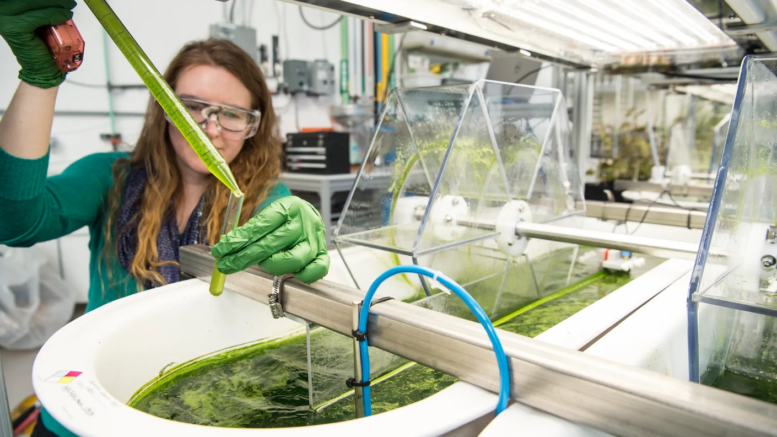As climate change becomes an increasingly urgent problem, we need creative and effective ways to reduce carbon emissions and protect the environment. One of the most promising solutions is algae farming—a surprisingly powerful way to combat global warming. Although small, algae have incredible potential to absorb carbon dioxide, create renewable energy, and even clean polluted water. This makes algae farms a versatile and sustainable way to help slow climate change and move toward a healthier future.
How Algae Help
1. Absorbing Carbon Dioxide
Algae are some of nature’s best carbon absorbers. Through photosynthesis, algae take in carbon dioxide (CO2) from the air even more efficiently than trees. Algae can absorb up to 2.5 times more CO2 per unit area than trees, making them especially effective at removing this greenhouse gas from the atmosphere. By growing algae in large-scale farms, scientists can significantly reduce the overall amount of CO2 in the air. In the future, algae farms can also be strategically located near factories or power plants to capture emissions before they’re released into the atmosphere. By converting CO2 into oxygen and biomass, algae help clean the air and offer a natural way to offset industrial pollution.
2. Producing Renewable Biofuels
Algae can do more than just absorb carbon—they can also produce biofuels. The oils found in algae can be converted into biodiesel, jet fuel, and other forms of renewable energy. These algae-based biofuels release far fewer carbon emissions than traditional fossil fuels, making them a cleaner and more sustainable energy option. What makes algae even better for biofuel production is that they don’t need many resources to grow. Unlike crops such as corn or soybeans, algae don’t require large amounts of land, water, or fertilizer. They can even grow in saltwater or wastewater, making them a far more environmentally friendly alternative for producing clean energy.
3. Creating Versatile Biomass
Beyond biofuels, algae farms also produce biomass—a nutrient-rich byproduct that can be used in various ways. Algae biomass can be turned into animal feed, fertilizers, or even health supplements rich in proteins and omega-3s. This makes algae farming not just beneficial for the environment but also valuable for agriculture and nutrition. For example, algae-based animal feed can be a sustainable alternative to traditional feed, which requires vast amounts of land and water. Algae-based fertilizers can improve soil health without the need for synthetic chemicals, helping promote sustainable farming practices.
4. Cleaning Polluted Water
Algae farms are also great for cleaning up polluted water. Algae can absorb excess nutrients like nitrogen and phosphorus, which often lead to harmful algal blooms and “dead zones” in oceans and lakes. By filtering out these pollutants, algae help restore the health of aquatic ecosystems and prevent further damage. Algae can even be used in wastewater treatment facilities, where they naturally filter contaminants from water. This not only improves water quality but also allows the algae to grow, providing more biomass for biofuels or other uses.
Why Algae Farms Make Sense
One of the best things about algae farming is that it doesn’t require fertile land. Algae can grow in a variety of environments, including deserts, urban areas, and even on rooftops. This flexibility makes algae farming a scalable solution that can be adapted to almost any region or climate. Furthermore, algae grows incredibly fast—some species can double in size in just a few days. This means that algae farms can capture CO2 and produce biofuels at a much faster rate than traditional agriculture practices. Because algae can grow in both saltwater and wastewater, it doesn’t compete with food crops for land or water, making algae farming an efficient and sustainable option. As land and water resources become scarcer, the ability to grow algae in unconventional spaces becomes even more relevant around the world.
What Needs to Happen Next
While algae farming shows huge potential, there are still a few challenges. Right now, producing biofuels from algae is more expensive than traditional fossil fuels, which makes it harder to compete in the energy market. However, ongoing research and technological improvements are helping bring these costs down, and with more investment, algae biofuels could become much more affordable. Building the infrastructure to support large-scale algae farms is another challenge. It takes time and money to create the facilities needed to grow, harvest, and process algae. Governments, private companies, and research institutions will need to work together to develop this infrastructure and make algae farming a widespread solution. There’s also a need for more public awareness. Many people don’t yet realize the benefits of algae farming or how it can contribute to fighting climate change. Spreading the word about the potential of algae can help build support for the technology and encourage investment in its development.
Conclusion
Algae farms offer a practical, scalable, and sustainable solution to climate change. They can absorb carbon dioxide, produce renewable energy, clean up polluted water, and create valuable byproducts for agriculture and other industries. While there are still challenges to overcome, the potential benefits of algae farming are too significant to ignore. With continued research, investment, and public support, algae farms could become a key part of the global effort to reduce carbon emissions and create a more sustainable future.






Be the first to comment on "Fighting Climate Change with Algae Farms: A Simple but Powerful Solution"